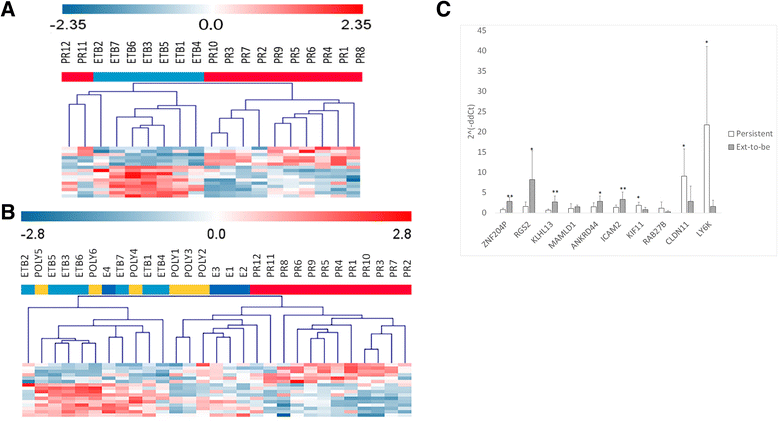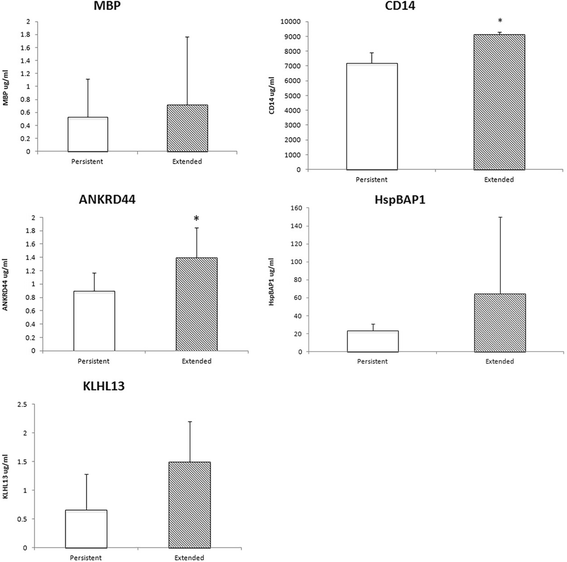Prior to extension, Transcriptomes of fibroblast-like Synoviocytes from extended and Polyarticular juvenile idiopathic arthritis are indistinguishable
- PMID: 29310668
- PMCID: PMC5759884
- DOI: 10.1186/s12969-017-0217-6
Prior to extension, Transcriptomes of fibroblast-like Synoviocytes from extended and Polyarticular juvenile idiopathic arthritis are indistinguishable
Abstract
Background: Our intent was to identify differences between the transcriptome of fibroblast-like synoviocytes (FLS) in oligoarticular juvenile idiopathic arthritis (JIA) before extension when compared to persistent subtype of JIA, when the two are clinically indistinguishable. Additionally, we sought to determine if differences between the transcriptomes of FLS from extended-to-be and polyarticular course JIA could be detected. Our hypothesis was that intrinsic differences in the transcriptome of the FLS from extended-to-be JIA would distinguish them from persistent oligoarticular JIA, before the course is clinically apparent.
Methods: Global gene expression was defined in cultured FLS from 6 controls, 12 JIA with persistent course, 7 JIA prior to extension (extended-to-be), 4 JIA with extended course and 6 polyarticular onset, using Affymetrix Human GeneChips 133plus2.0.
Results: Bioconductor Linear Models for Microarray Analysis revealed 22 probesets with differential expression between persistent and extended-to-be FLS at 15% FDR, however only 2 probesets distinguished extended-to-be from extended and none distinguished extended-to-be and polyarticular at 15% FDR. Differences in extended and polyarticular gene expression profiles were not detected. Confirmation of select genes was done on the RNA level by RT-qPCR and on the protein level in synovial fluid by ELISA.
Conclusions: The transcriptome of FLS from extended-to-be juvenile idiopathic arthritis is distinct from persistent course before a clinical distinction can be made. Additionally, the transcriptome of extended-to-be and polyarticular course, including those who have already extended, are indistinguishable. These gene expression data suggest that FLS already reflect a polyarticular behavior early in disease course, suggesting that extended-to-be may be "latent polyarticular" at onset. These differences can be used to develop early biomarkers of disease course, allowing for better-informed treatment decisions.
Keywords: Biomarkers.; Extended JIA.; Fibroblast-like synoviocytes.; Gene expression.; JIA subtypes.; Juvenile idiopathic arthritis; Microarray.; Transcriptome..
Conflict of interest statement
Ethics approval and consent to participate
This study was approved by the Nemours Institutional Review Boards. Samples were selected from our repository, which is formed under a separate Nemours Institutional Review Boards protocol, with consents and assents.
Consent for publication
Not applicable
Competing interests
The authors declare that they have no competing interests.
Publisher’s Note
Springer Nature remains neutral with regard to jurisdictional claims in published maps and institutional affiliations.
Figures


Similar articles
-
Single-cell analysis reveals heterogeneity of juvenile idiopathic arthritis fibroblast-like synoviocytes with implications for disease subtype.Arthritis Res Ther. 2022 Sep 27;24(1):225. doi: 10.1186/s13075-022-02913-8. Arthritis Res Ther. 2022. PMID: 36167601 Free PMC article.
-
The role of transforming growth factor β signaling in fibroblast-like synoviocytes from patients with oligoarticular juvenile idiopathic arthritis: dysregulation of transforming growth factor β signaling, including overexpression of bone morphogenetic protein 4, may lead to a chondrocyte phenotype and may contribute to bony hypertrophy.Arthritis Rheumatol. 2014 May;66(5):1352-62. doi: 10.1002/art.38336. Arthritis Rheumatol. 2014. PMID: 24782191 Free PMC article.
-
Methotrexate inhibits BMP4 and abrogates the hypertrophic chondrocyte phenotype of synovial fibroblasts in juvenile idiopathic arthritis.Pediatr Rheumatol Online J. 2024 Jan 2;22(1):6. doi: 10.1186/s12969-023-00940-6. Pediatr Rheumatol Online J. 2024. PMID: 38166938 Free PMC article.
-
Oligoarticular and polyarticular JIA: epidemiology and pathogenesis.Nat Rev Rheumatol. 2009 Nov;5(11):616-26. doi: 10.1038/nrrheum.2009.209. Epub 2009 Oct 6. Nat Rev Rheumatol. 2009. PMID: 19806151 Free PMC article. Review.
-
Immunogenetics of juvenile idiopathic arthritis: A comprehensive review.J Autoimmun. 2015 Nov;64:113-24. doi: 10.1016/j.jaut.2015.08.002. Epub 2015 Aug 21. J Autoimmun. 2015. PMID: 26305060 Free PMC article. Review.
Cited by
-
MicroRNA-27a-3p enhances the inflammatory phenotype of Juvenile Idiopathic Arthritis fibroblast-like synoviocytes.Pediatr Rheumatol Online J. 2023 Jun 6;21(1):53. doi: 10.1186/s12969-023-00833-8. Pediatr Rheumatol Online J. 2023. PMID: 37277817 Free PMC article.
References
-
- Petty RE, Southwood TR, Manners P, Baum J, Glass DN, Goldenberg J, et al. International league of associations for rheumatology classification of juvenile idiopathic arthritis: second revision, Edmonton, 2001. J Rheumatol. 2004;31(2):390–392. - PubMed
MeSH terms
Substances
Grants and funding
LinkOut - more resources
Full Text Sources
Other Literature Sources
Medical
Molecular Biology Databases

